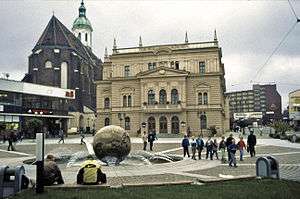Opava
| Opava | |||
| Statutory city (Czech Republic) | |||
 | |||
|
|||
| Country | Czech Republic | ||
|---|---|---|---|
| Region | Moravian-Silesian | ||
| District | Opava | ||
| River | Opava | ||
| Elevation | 257 m (843 ft) | ||
| Coordinates | CZ 49°56′N 17°54′E / 49.933°N 17.900°ECoordinates: CZ 49°56′N 17°54′E / 49.933°N 17.900°E | ||
| Area | 90.61 km2 (34.98 sq mi) | ||
| Population | 57,772 (31.12.2014) | ||
| Density | 638 / km2 (1,652 / sq mi) | ||
| First mentioned | 1195 | ||
| Mayor | Martin Víteček (ANO 2011) | ||
| Postal code | 746 01 | ||
  Location in the Czech Republic
| |||
  Location in the Moravian-Silesian Region
| |||
| Wikimedia Commons: Opava | |||
| Website: www.opava-city.cz | |||
Opava (Czech pronunciation: [ˈopava]; Silesian: Uopawa, German: Troppau, Silesian German: Tropp, Polish: Opawa, Latin: Oppavia) is a city in the northern Czech Republic on the river Opava, located to the north-west of Ostrava. The historical capital of Czech Silesia, Opava is now in the Moravian-Silesian Region and has a population of 59,843 as of January 1, 2005.
Geography
Opava is located on the Opava Hilly Land (Czech: Opavská pahorkatina; a part of the Silesian Lowlands) on the Opava River (left tributary of the Oder River) and Moravice River (right tributary of the Opava River).
History
Opava was first documented in 1195. First mention of Magdeburg city rights came from 1224. It was capital of the Silesian, Bohemian and finally Austrian Duchy of Opava.
In 1614 Karl I of Liechtenstein became Duke of Opava. After the majority of Silesia was annexed by the Kingdom of Prussia during the War of the Austrian Succession after 1740, the remaining Silesian territory still under the control of the Habsburg Monarchy became known as Austrian Silesia, with its capital in Troppau (1742–1918). The Congress of Troppau took place there in the period 27 October- 17 December 1820.[1]

According to the Austrian census of 1910, the town had 30,762 inhabitants, 29,587 of whom had permanent residence there. The census asked people for their native language, which showed that 27,240 (92%) were German-speaking, 2,039 (6.9%) were Czech-speaking and 274 (0.9%) were Polish-speaking. Jews were not allowed to declare Yiddish, and most of them thus declared German as their native language. The main religious group was Roman Catholics with 28,379 (92.2%), followed by Protestants with 1,155 (3.7%) and Jews with 1,112 (3.6%).[2]
After the defeat of Austria-Hungary in World War I, Troppau became part of Czechoslovakia in 1919 as Opava.

From 1938–45 Opava was part of Nazi Germany according to the Munich agreement. Already a day before Germany's annexation of the Sudetenland in 1938, the town seceded from its okres and became its own Stadtkreis. After the end of World War II, the entire German population of Opava was forcibly expelled in 1945–46 under terms included in the Beneš decrees; the city was resettled with Czechs. Many of the expelled population settled in Bamberg, Germany.
While the Duchy of Opava has ceased to exist, the title of Duke of Troppau lives on to present day, with Hans-Adam II, Prince of Liechtenstein being the current incumbent.
Economy and culture
Opava is currently an important business and cultural center of Opavian Silesia.[3] It is the location of several economic and cultural institutions serving the entire region, including the Silesian Museum which is the oldest Museum in the Czech Republic,[4] and the Silesian Institute of the Academy of Science. Opava is home to the only public university in the country not situated in a regional capital, the Silesian University (Opava). The city is part of a congested industrial area along with Ostrava and produces mining equipment. Opava also awards its own Cultural Prize.
The Silesian Theatre in Opava was founded in 1805. Plays were performed in German until the end of the Second World War.
Notable residents
- Joy Adamson, naturalist
- Franz Bardon, magician
- Petr Bezruč, poet
- Eduard von Böhm-Ermolli, Austrian field marshal
- Helmut Niedermeyer, Austrian businessman
- Martin of Opava, 13th century historian and cleric
- Joseph Maria Olbrich, architect
- Zuzana Ondrášková, tennis player
- Johann Palisa, astronomer
- Boris Rösner, actor
- Bohdan Sláma, film director
- Pavel Složil, tennis player
- Josef Gebauer, historian
International relations
Opava is twinned with:
References
- ↑ Chronologie des civilisations, Jean Delorme, Presses universitaires de France, 1956
- ↑ Ludwig Patryn (ed): Die Ergebnisse der Volkszählung vom 31. Dezember 1910 in Schlesien, Troppau 1912.
- ↑ Opavian Silesia
- ↑ About Silesian Land's Museum (in czech) – "Slezské zemské muzeum je nejstarší muzeum v České republice. Bylo založeno v Opavě 1. května 1814." → "Silesian Land's Museum is the oldest museum in the Czech Republic. It was founded in Opava 1 May 1814."
External links
| Wikimedia Commons has media related to Opava. |
- Official website
- News from Opava
- staraopava.cz Old postcards (Czech language)
- Opava International Organ Competition
|

